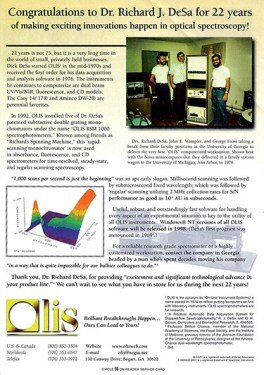Our Uv/vis Ideas
The Main Principles Of Circular Dichroism
Table of ContentsSome Known Factual Statements About Uv/vis Not known Incorrect Statements About Uv/vis/nir An Unbiased View of SpectrophotometersThe Spectrophotometers DiariesAll About Spectrophotometers

Spectrophotometry is a tool that hinges on the quantitative analysis of particles depending on how much light is taken in by colored substances.
The Basic Principles Of Spectrophotometers
A spectrophotometer is typically used for the measurement of transmittance or reflectance of services, transparent or nontransparent solids, such as polished glass, or gases. Although lots of biochemicals are colored, as in, they take in noticeable light and for that reason can be measured by colorimetric procedures, even colorless biochemicals can often be converted to colored compounds appropriate for chromogenic color-forming responses to yield substances appropriate for colorimetric analysis.: 65 However, they can also be created to measure the diffusivity on any of the listed light ranges that normally cover around 2002500 nm using different controls and calibrations.
An example of an experiment in which spectrophotometry is utilized is the decision of the equilibrium constant of a service. A specific chain reaction within a solution might take place in a forward and reverse direction, where reactants form items and items break down into reactants. At some time, this chain reaction will reach a point of balance called a stability point.
3 Simple Techniques For Spectrophotometers
The quantity of light that travels through the option is a sign of the concentration of specific chemicals that do not allow light to pass through. The absorption of light is because of the interaction of light with the electronic and vibrational modes of molecules. Each kind of molecule has an individual set of energy levels connected with the makeup of its chemical bonds and nuclei and therefore will absorb light of particular wavelengths, or energies, leading to unique spectral residential or commercial properties.
They are widely utilized in many industries consisting of semiconductors, laser and optical production, printing and forensic evaluation, as well as in labs for the study of chemical substances. Spectrophotometry is typically used in measurements of enzyme activities, determinations of protein concentrations, determinations of enzymatic kinetic constants, and measurements of ligand binding reactions.: 65 Eventually, a spectrophotometer is able to determine, depending on the control or calibration, what compounds are present in a target and exactly how much through computations of observed wavelengths.
Invented by Arnold O. Beckman in 1940 [], the spectrophotometer was produced with the help of his coworkers at his company National Technical Laboratories founded in 1935 which would end up being Beckman Instrument Business and ultimately Beckman Coulter. This would come as an option to the previously developed spectrophotometers which were review not able to absorb the ultraviolet correctly.
Everything about Circular Dichroism
It would be found that this did not provide satisfactory outcomes, for that reason in Model B, there was a shift from a glass to a quartz prism which permitted much better absorbance outcomes - circular dichroism (https://us.enrollbusiness.com/BusinessProfile/6552779/Olis%20Clarity). From there, Design C was born with an adjustment to the wavelength resolution which ended up having 3 systems of it produced
It was produced from 1941 to 1976 where the price for it in 1941 was US$723 (far-UV accessories were a choice at additional expense). In the words of Nobel chemistry laureate Bruce Merrifield, it was "most likely the most important instrument ever established towards the development of bioscience." Once it became terminated in 1976, Hewlett-Packard developed the first commercially available diode-array spectrophotometer in 1979 known as the HP 8450A. It irradiates the sample with polychromatic light which the sample takes in depending on its residential or commercial properties. It is transferred back by grating the photodiode variety which finds the wavelength region of the spectrum. Ever since, the development and implementation of spectrophotometry devices has actually increased exceptionally and has actually turned into one of the most ingenious instruments of our time.

Uv/vis Can Be Fun For Everyone
Historically, spectrophotometers utilize a monochromator including a diffraction grating to produce the analytical spectrum. The grating can either be movable or repaired. If a single detector, such as a photomultiplier tube or photodiode is used, the grating can be scanned step-by-step (scanning spectrophotometer) so that the detector can determine the light intensity at each wavelength (which will represent each "step").
In such systems, the grating is repaired and the intensity of each wavelength of light is determined by a various detector in the range. When making transmission measurements, the spectrophotometer quantitatively compares the portion of light that passes through a referral solution and a test option, then digitally compares the strengths of the two signals and computes the portion of transmission of the sample compared to the recommendation standard.
